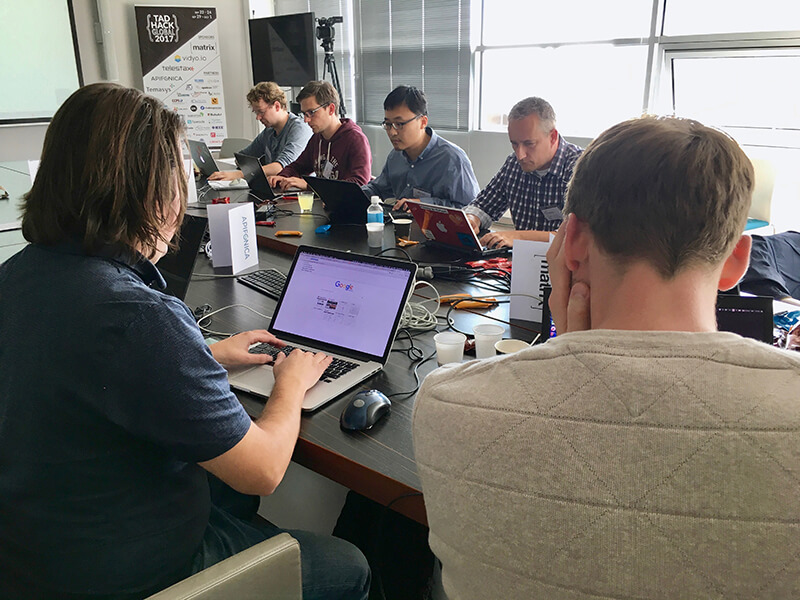How to Organize a Successful Hackathon without Losing Your Mind
If you are doing something, you make mistakes. This is a necessary evil in order to grow, both personally and as a company. Resistance is there for you, not against you! Therefore, even when you read this post, you are probably going to make mistakes as well. What it can bring you is a higher level of execution and more confidence. Ideas are just a multiplier of execution, as Derek Sivers said.
Our ideas for building a great Hackathon

1. Make or use a qualitative concept (Product)
Because we are in the Telecom/API business we joined forces with TADHack. This Telecom Application Development initiative is a non-profit aim to build an ecosystem focused on telecom application development. The worldwide organization has built some great Hackathon concepts, with pre-made templates. Furthermore, they organize a worldwide hackathon event with global sponsors and converged media outreach, making it the perfect ground to organize our local hackathon. Another important thing is to make your concepts tailor-made so that it hooks into the latest trends. This makes it more attractive.
Task: Find your industry’s non-profit organization that co-organizes your hackathon and make your concept tailor-made to the latest trends.
2. Choose the right city (Market)
Maybe too obvious but certainly important enough to mention it - define your target audience very clearly (what exact type of developers am I trying to reach?), and then pick a city where the highest number of those developer communities exist. In our experiences, expats and non-local people are far more interested in these events as they have a more pioneering mindset. And more importantly, a hackathon is a way to feel connected with people and their interests.
Task: Define audience and location of this audience.
3. Focus on marketing & sales
If you defined your product and market, now you need to bring this product TO the market. Although we are living in a society with a lot of media channels, this still is the most challenging part of the organization.
Define benefits clearly (message)
You need to describe what benefits will the target audience get by visiting your hackathon. Try to make it personal and unique in comparison to any other hackathon. If you describe it too vaguely, people are not going to be convinced to put aside some of their precious time for YOUR hackathon. Make it clear that they benefit as well.
Task: Make your message to the audience loud and clear in an email and social media.
Either go for close relationships OR massive reach (Medium)
This one is most of the time overlooked. Many times, the situation is somewhere in between - bad developed relationships and mediocre media outreach. We almost fell into this trap ourselves. This is why you need to choose carefully one of the two to focus on. If you choose to get attendees by cultivating close relationships, they need to be developed over time, taking at least 6-12 months. If you decide massive reach is a better fit for you, you will need to find a big industry leader/competitor that wants to co-organize this event and is willing to promote it to their audience.
Task: Choose a strategy: either close relationships or mass promotion.
Build a well-thought registration pipeline (Sales/backend)
Keep in mind that registration process is still at sales end of the project. This means that your potential attendees might still go away if you don’t do it right. Usability and conversion need to be optimized to dramatically if you don’t want people to go away without signing up. Think of one place to register. If you have multiple media channels, point them all to the same registration page. Furthermore, gather all the necessary information to be able to follow up on them. And feed them in automated systems, such as SMS services, Autoresponders, etc. Nobody wants to copy/paste information from spreadsheets.
Task: Build an optimal and centralized registration pipeline.
Follow up and inform constantly (Sales/backend)
Sales is not a one-time action. The target audience needs to be reminded over and over again with the same coherent message in such a way that they perceive it as useful and not as spam. This can be done by email, phone calls or text messages. Let them know their friends are welcome to come as well. This should be done for your colleagues and sponsors as well (many people forget that part).
Task: Define your follow-up strategy.
4. Facility management is easy. Give it a low priority. (Product)
Most of the time, because this part of the organization is the easiest, people tend to start here. But you should actually give this the lowest priority. Even though you want everything to be arranged well, most things, if forgotten, are not critical and can be arranged within hours on the day itself. Even audio/video, food, etc. can most of the times be arranged very fast. If you want to do this smoothly while still being able to focus your efforts on marketing, assign each team member to be responsible for a certain area (Location, AV, Food/Beverage, Print, etc.).
Task: Assign areas of responsibility to your teammates and delegate tasks.
And finally, and most importantly:
- Create a well-rounded team of committed organizers.
- Ask them to specify how many hours a week they are able to contribute
- Set up IT well (Group chat, Group task board, File sharing), and
- Set a recurring team meeting to discuss progress (for example, two times a week).
Subscribe to Talksome blog
Get the latest posts delivered right to your inbox
